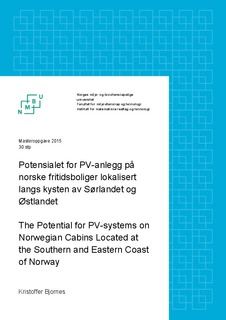| dc.description.abstract | Det elektriske energiforbruket til norske fritidsboliger har mer enn doblet seg siden 1990-tallet med stadig flere og større fritidsboliger tilkoblet strømnettet. Økningen i bruken av elektrisk energi fra fritidsboliger øker langt raskere enn bruken i vanlige husholdninger, og vil i fremtiden utgjøre en stadig større andel av det totale forbruket innenfor husholdningssektoren. For å møte det økte behovet for elektrisitet med fornybar energi ble det sett på muligheten for PV anlegg på norske fritidsboliger. Området som ble undersøkt var kysten av Sør- og Østlandet i Norge hvor tettheten av norske fritidsboliger er størst og globalstrålingen er høy etter norske forhold.
Meteorologiske data fra Meteonorm ble sammenlignet med meteorologiske data fra Bioforsk-stasjonene Landvik, Tjølling og Ås. Det ble laget et normalår basert på årene 1997–2014 fra Bioforsk-stasjonene. Dette normalåret ble brukt i simuleringen av PV-anlegget. Simuleringer av anlegget ble utført i programmet PVsyst. PV-anlegget ble plassert på den mest optimale halvdelen av taket på en tenkt fritidsbolig og dekket 39,4 m2 av taket. Anlegget hadde en maks effekt på 6,0 kW. Simuleringer ble kjørt med følgende helningsvinkler på taket: Optimal vinkel, 27 grader og 10 grader. Og følgende orientering: Asimut 0 grader (rett mot syd), asimut -45 grader og asimut -90 grader (rett mot vest). Videre ble dekningsgraden av forbruket undersøkt basert på forbruksdata fra AMS-prosjektet i Hvaler kommune.
Den gjennomsnittlige årlige globalstrålingen for området ble funnet til å være 0,92 MWh/m2 ved bruk av Meteonorm og 0,98 MWh/m2 ved bruk av data fra Bioforsk-stasjonene. Den årlige produksjonen til et anlegg med optimal helningsvinkel og orientering ble funnet til å være 6,0 MWh. Fritidsboligen som ble valgt til å representere standardfritidsboligen med 27 graders takvinkel og en asimut på -45 grader hadde en simulert produksjon på 5,6 MWh. Årlig forventet forbruk fra fritidsboliger i samme område ble funnet til å være 4,3 MWh. Antall timer forbruket ble dekket av produksjonen til PV-anlegget, ble funnet til å være 9,5 % i vintermånedene, 43 % i vårmånedene, 59 % i sommermånedene og 25 % i høstmånedene. Totalt for året ble 34 % av timene dekket av produksjonen fra PV-anlegget.
.
.
Abstract
The electrical energy consumption by Norwegian cabins has more than doubled since 1990. The cabins are getting bigger in size and consume more electrical energy because of a higher standard of living. In addition, cabins that before were not connected to the electrical grid are now connected. The increase in electrical energy consumption rises more rapidly for cabins than normal households, and this will lead to a bigger share of the total consumption in the future. To meet the rising demand for electrical energy consumed by the cabins, this thesis investigate the possibility of installing PV-systems on the roof of these cabins. The cabins investigated in this thesis are located at the southern and eastern coast of Norway. The density of cabins and global irritation is high in this area after Norwegian conditions.
Meteorological data from Meteonorm was compared to data from local meteorological stations operated by Bioforsk. The Bioforsk stations were located at Landvik, Tjølling and Ås. A normal was created based on the years 1997–2014, and used in further simulations. The simulations were performed in the program PVsyst. The PV-system was located on the most optimal part of the roof and covered an area of 39.4 m2. The peak power of the PV-system was 6.0 kW. Different settings for the slope of the roof and the orientation of the building were used. The settings for roof slopes were 10 degrees, 27 degrees and optimal slope. For the orientation azimuth 0 (directly south), azimuth -45 and azimuth -90 were investigated. Lastly, an analyze was performed on how much of the hourly consumption the PV-system could cover based on data from the AMS-project in Hvaler.
The mean annual global irradiation for the area was found to be 0.92 MWh/m2 with use of the Meteonorm service and 0.98 MWh/m2 with use of the Bioforsk data. The yearly production for the optimal system was found to be 6.0 MWh. For the standard cabin with the slope of the roof at 27 degrees and orientation with azimuth -45 the yearly production was found to be 5.6 MWh. Estimated consumptions for cabins in the same area was found to be 4.3 MWh based on consumption data from Hvaler. The hourly coverage of consumption was found to be 9.5 % in the winter months, 43 % in the spring months, 59 % in the summer months and 25 % in the autumn months. For the whole year, 34 % of the total hours were covered by the PV-system. | nb_NO |
